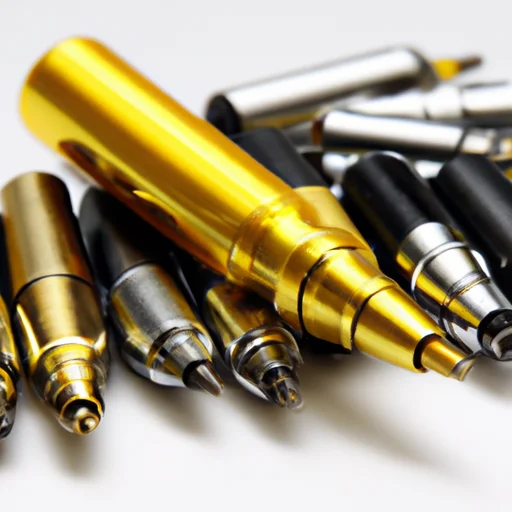Are you tired of struggling to find the perfect tip for different coatings? Look no further, because in this article, we have the solution for you! We will guide you through the process of selecting the right tip that will ensure a flawless finish on various surfaces. Whether you’re an experienced painter or a novice, we’ve got you covered with our helpful tips and tricks. So, let’s dive in and discover how you can choose the perfect tip for different coatings!
How To Choose The Right Tip For Different Coatings
Table of Contents

Types of Coatings
Water-based Coatings
Water-based coatings are popular choices for various applications due to their low VOC (volatile organic compounds) content and environmental friendliness. They are easy to clean up with water and are commonly used for interior and exterior painting projects. Water-based coatings have a fast drying time and provide a smooth finish. They are suitable for spraying on a variety of surfaces, including wood, metal, and concrete.
Oil-based Coatings
Oil-based coatings are known for their durability and ability to provide a high-quality finish. They are commonly used for projects that require a more robust coating, such as furniture or cabinetry refinishing. Oil-based coatings take longer to dry compared to water-based coatings and require mineral spirits or other solvents for cleanup. They are compatible with a wide range of surfaces, including wood, metal, and masonry.
Solvent-based Coatings
Solvent-based coatings are formulated with organic solvents as the main liquid component. They offer excellent adhesion and resistance to chemicals, making them suitable for applications that require resistance to harsh environments. Solvent-based coatings have a longer drying time compared to water-based and oil-based coatings. They are commonly used in industrial settings for coating metal surfaces and automobile refinishing.
Factors to Consider
Viscosity of the Coating
The viscosity of the coating plays a crucial role in choosing the right tip size. A coating with high viscosity requires a larger tip size to ensure a proper spray pattern and prevent clogging. Conversely, a coating with low viscosity will need a smaller tip size for a finer finish.
Desired Finish
Consider the desired finish when choosing a tip size. A smaller tip size will create a finer atomization and provide a smoother finish, while a larger tip size will produce a thicker coating and a more textured finish.
Surface Material
Different surface materials may require different tip sizes. Porous surfaces, such as wood and concrete, often require a larger tip size to ensure proper coverage, while smoother surfaces, such as metal, may benefit from a smaller tip size for a more precise finish.
Sprayer Type
The type of sprayer being used should be taken into account when selecting a tip size. Airless sprayers typically require larger tip sizes due to their high pressure, while HVLP (high volume low pressure) sprayers work best with smaller tip sizes.
Spraying Technique
Your spraying technique can also impact tip size selection. If you tend to spray closer to the surface, a smaller tip size may be more suitable to avoid excessive overspray. However, if you paint from a farther distance, a larger tip size may be necessary to ensure adequate coverage.
Choosing the Right Tip Size
Understanding Tip Sizes
Tip sizes are identified by a three-digit number, such as 415 or 517. The first digit represents the fan width, while the last two digits indicate the orifice size in thousandths of an inch. Understanding these numbers is essential for selecting the right tip size for your specific coating and application.
Tip Size Chart
Consulting a tip size chart can simplify your decision-making process. These charts provide recommendations for different coatings and desired finishes based on the specific tip size. It is important to note that these charts serve as a general guideline, and adjustments may be necessary based on your personal preferences and project requirements.
Tips for Different Coatings
Different types of coatings require different tip sizes for optimal results. For latex paints, a tip size of 213 to 515 is commonly recommended. Oil-based coatings may work well with tip sizes ranging from 413 to 615. Thicker coatings, such as epoxy or polyurethane, typically require larger tip sizes, such as 513 or 617. Always refer to the coating manufacturer’s instructions and conduct a test spray to ensure compatibility and achieve the desired finish.
Choosing the Right Tip Type
Airless Tips
Airless tips are designed for high-pressure spraying applications. They are commonly used with airless sprayers and are known for their versatility and productivity. Airless tips are available in various sizes and can handle a wide range of coatings, including latex paints, stains, and enamels. They are suitable for both residential and commercial projects.
Air-Assisted Tips
Air-assisted tips, also known as air-assisted airless tips, combine airless and air spray technologies. They offer a higher transfer efficiency and a finer finish compared to airless tips alone. Air-assisted tips are often used for furniture refinishing, automotive painting, and other projects that require a superior level of control and a high-quality finish.
HVLP Tips
HVLP tips are specifically designed for HVLP spray guns, which operate at lower pressures and provide a more controlled spray pattern. These tips are ideal for projects that require minimal overspray and a high level of precision, such as woodworking or automotive touch-ups. HVLP tips are available in smaller sizes and are compatible with a wide range of coatings.
Fine Finish Tips
Fine finish tips are designed for achieving exceptional finishes on surfaces that require a high level of detail and smoothness. These tips provide a finer atomization and are commonly used for applications such as cabinetry, trim work, and decorative painting. Fine finish tips are available in smaller sizes and can be used with both airless and HVLP spraying systems.
Spray Pattern Selection
Fan Width
The fan width refers to the width of the spray pattern produced by the tip. It is typically measured in inches. Choosing the right fan width depends on the size of the surface being sprayed and the desired coverage. A narrower fan width is suitable for smaller surfaces and precise applications, while a wider fan width is more efficient for larger areas.
Pattern Shape
Pattern shape refers to the distribution of the spray pattern, which can be either a horizontal, vertical, or round shape. The pattern shape is determined by the orientation of the air cap or tip. Different patterns are used depending on the shape and size of the surface being sprayed. For example, a horizontal pattern may be preferred for spraying wide, horizontal surfaces such as floors or tabletops.
Adjustable Pattern Tips
Some tips come with adjustable pattern features, allowing you to adjust the spray pattern shape and width. These tips offer increased flexibility and control, as they can adapt to different project requirements and surface shapes. Adjustable pattern tips are particularly useful when working on intricate or irregular surfaces.
Maintaining and Cleaning Tips
Cleaning Tips
Proper maintenance and cleaning of tips are essential for optimal performance and prolonging their lifespan. After each use, it’s important to clean the tip thoroughly to remove any residue or dried coating. Use a cleaning solution recommended by the coating manufacturer and follow the specific cleaning instructions provided. A clean tip ensures consistent spray patterns and prevents blockages.
Removing Blockages
If a tip becomes clogged or blocked, it can disrupt the spray pattern and affect the quality of the coating application. To remove blockages, carefully remove the tip from the spray gun and rinse it with an appropriate cleaning solution. You can also use a small cleaning brush or a tip cleaning tool to remove any stubborn debris. Regular cleaning and preventive maintenance can help minimize the occurrence of blockages.
Storing and Reusing Tips
When not in use, it’s important to store tips properly to prevent damage or clogging. After cleaning, allow the tip to dry thoroughly before storing it in a protective case or container. Avoid placing the tip directly on a hard surface that could cause damage. When reusing tips, always check for signs of wear or damage, such as worn or deformed orifice openings, and replace them if necessary.
Troubleshooting Tips
Uneven Coating
If you notice an uneven coating during application, the tip size and spray technique may need adjusting. Consider changing to a larger or smaller tip size to achieve better coverage and atomization. Additionally, check that the sprayer is properly calibrated and that the pressure settings are appropriate for the coating being used. It may also be helpful to practice your spraying technique to ensure consistent movement and overlap.
Drips and Runs
Drips and runs occur when too much coating is applied or when the sprayer is held too close to the surface. To avoid drips and runs, maintain a consistent distance from the surface and apply thin, even coats. Adjusting the spray technique and using an appropriate tip size can also help minimize the occurrence of drips and runs.
Clogging
Tip clogging can happen due to dried coating residue, debris, or using the wrong tip size for the coating being sprayed. Regular cleaning and proper maintenance can help prevent clogging. If clogging occurs during application, stop spraying and clean the tip thoroughly. Consider using a tip strainer or filter to prevent debris from reaching the tip and causing clogs.
Orange Peel Effect
The orange peel effect refers to a textured, bumpy finish resembling the surface of an orange peel. It can occur due to various factors, including improper tip size, excessive coating thickness, improper thinning of the coating, or applying the coating at an incorrect pressure. To minimize the orange peel effect, ensure the tip size is appropriate for the coating, thin the coating if necessary, and adjust the spray pressure to achieve a smoother finish.
Safety Considerations
Protective Gear
When using any coating and spray equipment, it is important to prioritize safety. Wear appropriate personal protective equipment (PPE), including safety goggles, a respirator or mask, gloves, and protective clothing. This helps protect you from potential respiratory, eye, and skin hazards associated with coatings and spray operations.
Ventilation
Ensure proper ventilation in the spraying area to minimize exposure to fumes and overspray. Spray in a well-ventilated space or use exhaust fans and ventilation equipment to remove airborne particles and maintain fresh air circulation. Proper ventilation helps reduce the risk of inhaling harmful vapors and improves the overall painting environment.
Flammability and Toxicity
Be aware of the flammability and toxicity risks associated with certain coatings and solvents. Follow the manufacturer’s instructions and safety data sheets (SDS) to understand the hazards, handling precautions, and disposal protocols. Store coatings and solvents in a safe and well-ventilated area, away from sources of ignition and out of reach of children or unauthorized individuals.
By considering factors like viscosity, desired finish, surface material, sprayer type, and spraying technique, you can choose the right tip size, type, and spray pattern to achieve professional and successful coating applications. Proper maintenance, troubleshooting, and adherence to safety considerations ensure a smooth and enjoyable coating experience, bringing your projects to life with outstanding results. Happy spraying!

Upgrade Your Painting Game
Explore our Introduction To The Best Paint Sprayers guide to take your projects to the next level!

